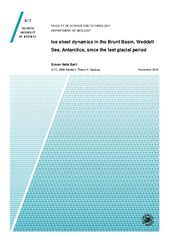| dc.description.abstract | High-resolution swath bathymetry, TOPAS sub-bottom profiles and four gravity cores from the Brunt Basin, southeastern Weddell Sea in Antarctica, were analysed with the purpose of reconstructing the ice sheet dynamics since the last glacial. Data collection was carried out by the British Antarctic Survey (BAS) and data analyses were carried out in a collaboration between the Department of Geosciences at UiT the Arctic University of Norway in Tromsø and BAS.
The swath bathymetry and TOPAS sub-bottom profiles were analysed to investigate the seafloor morphology and sub-bottom acoustic information, in order to identify glacial landforms indicative of ice sheet extent, basal regime and dynamics during the last extensive ice advance and its subsequent retreat. Multi-proxy analyses of the gravity cores were performed to determine depositional environments. This included physical properties, e.g. wet-bulk density, shear strength and magnetic susceptibility, the acquisition and interpretation of X-radiographs and line-scan images, qualitative element-geochemical analyses using an Avaatech XRF core scanner, analyses of the bulk granulometry and, in particular, of the sand fraction, as well as smear-slide investigations. Three radiocarbon dates were obtained from calcareous material, and one radiocarbon date was obtained from the acid insolvable organic fraction of the sediments.
The swath bathymetry displays a widespread distribution of glacial landforms providing evidence of past ice sheet activity within the study area. This includes subglacial landforms indicative of fast flowing ice, such as mega-scale glacial lineations, glacial lineation. Lateral shear-moraines, formed subglacial at the transition between fast and slow flowing ice. Additionally, ice-contact features such as grounding zone-wedges and recessional moraines, provide information about extent and dynamics during the deglaciation. Locally abundant iceberg scouring has eradicated any evidence of past ice sheet extent that might have formed during full glaciations within the outermost 24 km of the continental shelf of the Brunt Basin.
The TOPAS sub-bottom profiles and the gravity cores provide additional information about the glacial regime and ice-sheet dynamics within the study area. Acoustically transparent layers, corresponding to soft deformation till recovered in the gravity cores, indicate widespread deformation sliding at the base of a fast flowing ice stream in the middle and outer basin. In the northern part of the inner basin ice flow occurred as localized basal sliding, whereas slow flowing ice occupied the southern part of the inner basin and the shallower bank.
One radiocarbon date obtained from glaciomarine sediments 20 cm above the transition from the subglacial sediments, yields an age of ~8.5 calibrated kilo years before the present (cal. ka BP), indicating that the subglacial sediments and landforms were formed during the last glaciation. Assuming constant sedimentation rates after grounding line retreat, deglaciation of the inner part of the Brunt Basin occurred ~11.9 cal. ka BP.
Low to absent biogenic contents within the sediments deposited after the deglaciation, indicate that extensive ice shelves or perennial sea ice cover were located above the core locations prior to ~2.8 cal. ka BP, when the onset of seasonal open marine environment occurred. The latter resulted in increased productivity in the water masses. However, the biogenic content remained relatively low and sediment deposition occurred mainly from iceberg rafting. | en_US |


 English
English norsk
norsk
